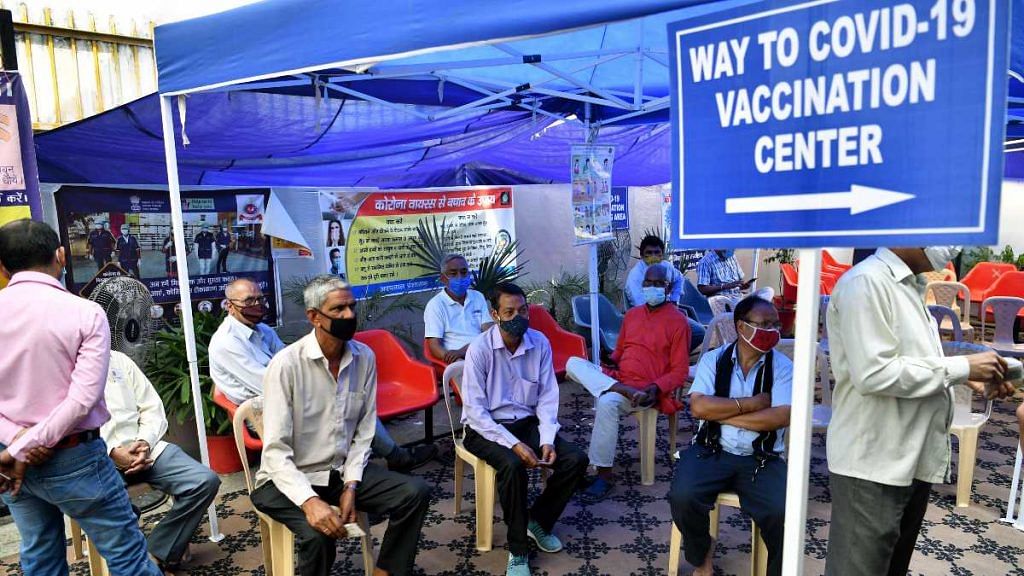New Delhi: As India tops the world list of daily Covid-19 cases, many states now have lockdown restrictions, the hospitality sector is suffering, and more and more cities are imposing night curfew.
In episode 719 of ‘Cut the Clutter’, ThePrint’s Editor-in-Chief Shekhar Gupta explained why India’s vaccination rate is poor despite being the manufacturer of preeminent vaccines.
Dr Randeep Guleria, Director of All India Institute of Medical Sciences, has said the virus doesn’t come to homes until we invite it. “The virus is now back. If you see the current wave, it is rising much more steeply than the previous one. We crossed 1,50,000 cases Tuesday, which is an all-time record and is going to go higher,” Gupta said.
“It is unfortunate that this (rise in cases) is happening at a time when we (India) have an array of weapons against it,” Gupta added.
India is the preeminent manufacturer of three vaccines — Oxford-AstraZeneca, Bharat Biotech’s Covaxin and the Sputnik vaccines. Moreover, Biological E has the licence to produce the one-shot Johnson & Johnson vaccine.
After the Quad summit this year, it was decided that Quad countries will spend a large sum of money on producing vaccines and a lot of that has come to Indian companies for the Johnson & Johnson vaccine, said Gupta.
Also read: AstraZeneca clot worries are complicating the race to vaccinate the world
India’s vaccine crisis
Despite all of this, India is short of vaccines. Maharashtra has said it will run short of supplies in three days. “We always knew that we have a population of 138 crore — it is the most well-known fact. So how is it that we didn’t prepare? One reason we didn’t prepare, quite evidently, is because we thought that the pandemic was over and there was herd immunity,” Gupta said.
“Decisions have been taken on the run — we wasted six months in our preparations for vaccines. We didn’t secure our own supply of our vaccines,” he added. The first orders of vaccines by the government with Indian manufacturers was after 3 January 2021 — once emergency use approval had been granted.
However, smarter countries had secured their vaccine supplies much earlier.
In the United States, former president Donald Trump started ‘Operation Warp Speed’ under which billions of dollars were paid to vaccine manufacturers to start producing doses even when trials were going on. More than one-third of the country is already vaccinated. From 19 April, every American adult can get vaccinated.
In India, whatever was stockpiled is being used but no manufacturer had the money to scale up the production. Now, the manufacturers are saying that they need money to scale up the production, especially at the price set.
The United Kingdom has vaccinated nearly 60 per cent of its population as the country had proactively booked their supplies of Pfizer and AstraZeneca. Israel’s Prime Minister Benjamin Netanyahu booked as many Pfizer vaccines as he could by paying twice the market price.
“India’s ranking is among the poorest in terms of vaccines per 100 persons,” revealed Gupta.
Brazil has vaccinated 8.5 per cent of the population, Mexico about 7.5 per cent and India just about 5 per cent.
Also read: Modi govt says there’s no vaccine shortage, but states & hospitals tell a different story
India tops all wrong metrics
India’s tracking of the new variants is very poor, Gupta, added, with less than 1 per cent of the new positive cases being tested at genomic labs.
The UK has been doing more than 8 per cent tests and crossed 33 per cent last week. The US is now at 4 per cent and rising.
“One per cent is too low when India’s daily cases and daily deaths are highest in the world,” Gupta said.
India is averaging 2.6 million vaccines a day over the last couple of weeks but with this average, it will take two years to vaccinate 75 per cent of the population.
Gujarat is the best performing state in the country for vaccinations, among large states. Unlike Maharashtra, it has been proactive in vaccinations, which might be one of the reasons that cases and fatalities haven’t surged in Gujarat as much as in the neighbouring state.
The second most successful state is Chhattisgarh at 9 per cent, while Rajasthan is at 7.5 per cent, Kerala at nearly 7 per cent, and Karnataka at nearly 6 per cent.
Uttar Pradesh is at the very bottom with 2.9 per cent and Bihar at 2.31 per cent while Punjab is at 3.65 per cent.
“Punjab has three times more people dying of Covid-19 than the rest of the country and almost seven times more people dying per million than Kerala,” Gupta said.
Haryana is getting close to 6 per cent. Delhi is just around 5 per cent and is way behind Rajasthan, Chhattisgarh and Gujarat. Gupta said Maharashtra accounts for nearly 60 per cent of all of India’s daily Covid-19 cases and deaths, and yet has a vaccination rate of just about 4.5 per cent.
Watch the full CTC episode here:
